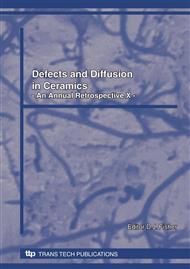p.9
p.15
p.21
p.29
p.79
p.85
p.97
p.105
p.113
Formation of Point Defects in Dilute FCC Alloys
Abstract:
Using pseudopotential approach, vacancy formation energy , different non-split interstitial formation energies and binding energy for the vacancy-impurity pair and that for interstitial impurity over host have been calculated in some cubic fcc metal systems, viz. copper, silver, gold and lead using Ashcroft's potential and Taylor's exchange and correlation function with standard (AT) and fitted to (ATF) and also Heine-Abarenkov’s model potential and same exchange and correlations (HAT). It is difficult to have a universal value for all types of atomic property calculations. The results show that ATF and HAT combinations are better in comparison to AT. Also, the substitutional impurity adjacent to a vacancy is found to be more loosely bound than the interstitial impurity in fcc metals.
Info:
Periodical:
Pages:
79-84
Citation:
Online since:
November 2008
Authors:
Keywords:
Price:
Сopyright:
© 2008 Trans Tech Publications Ltd. All Rights Reserved
Share:
Citation:


